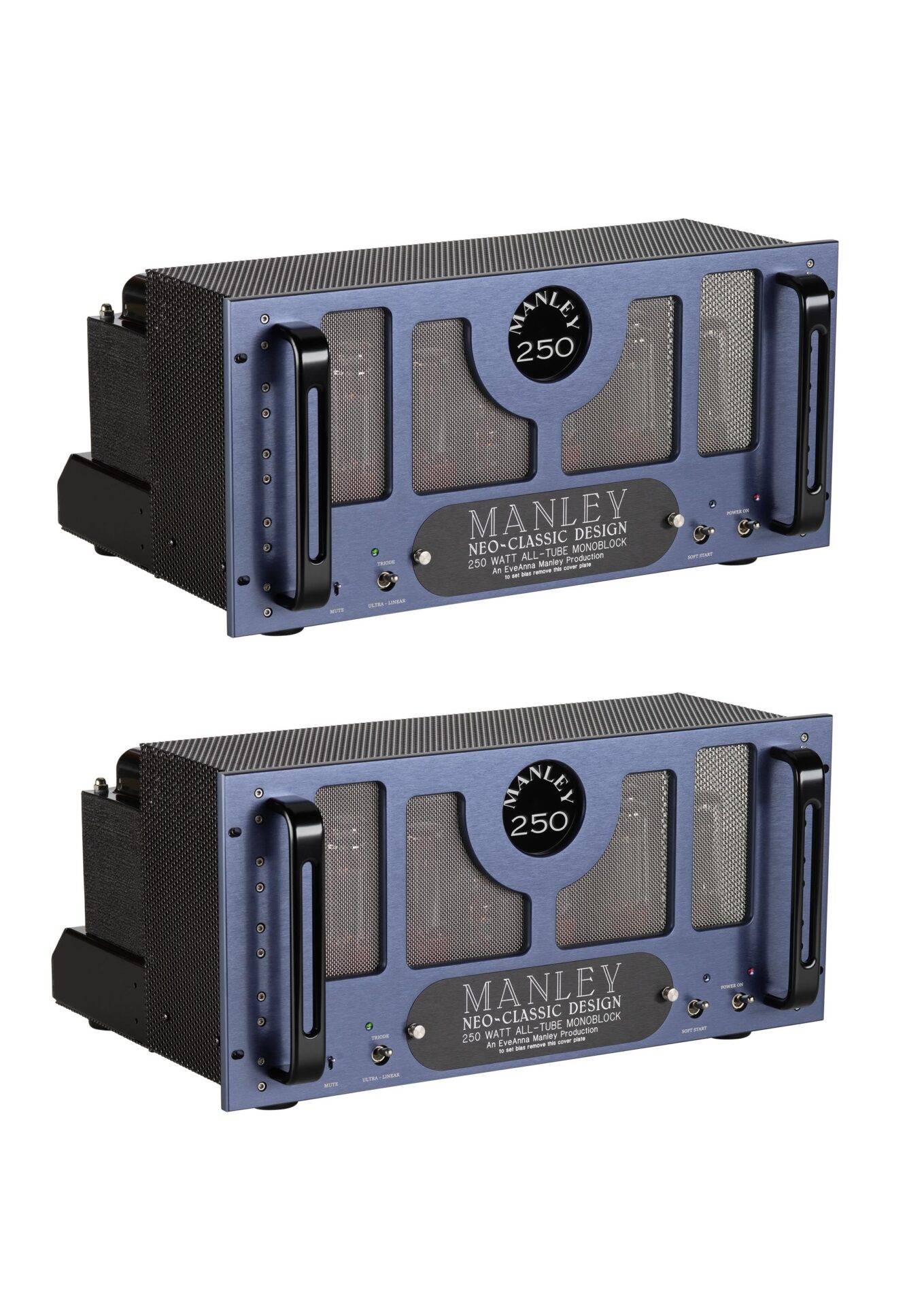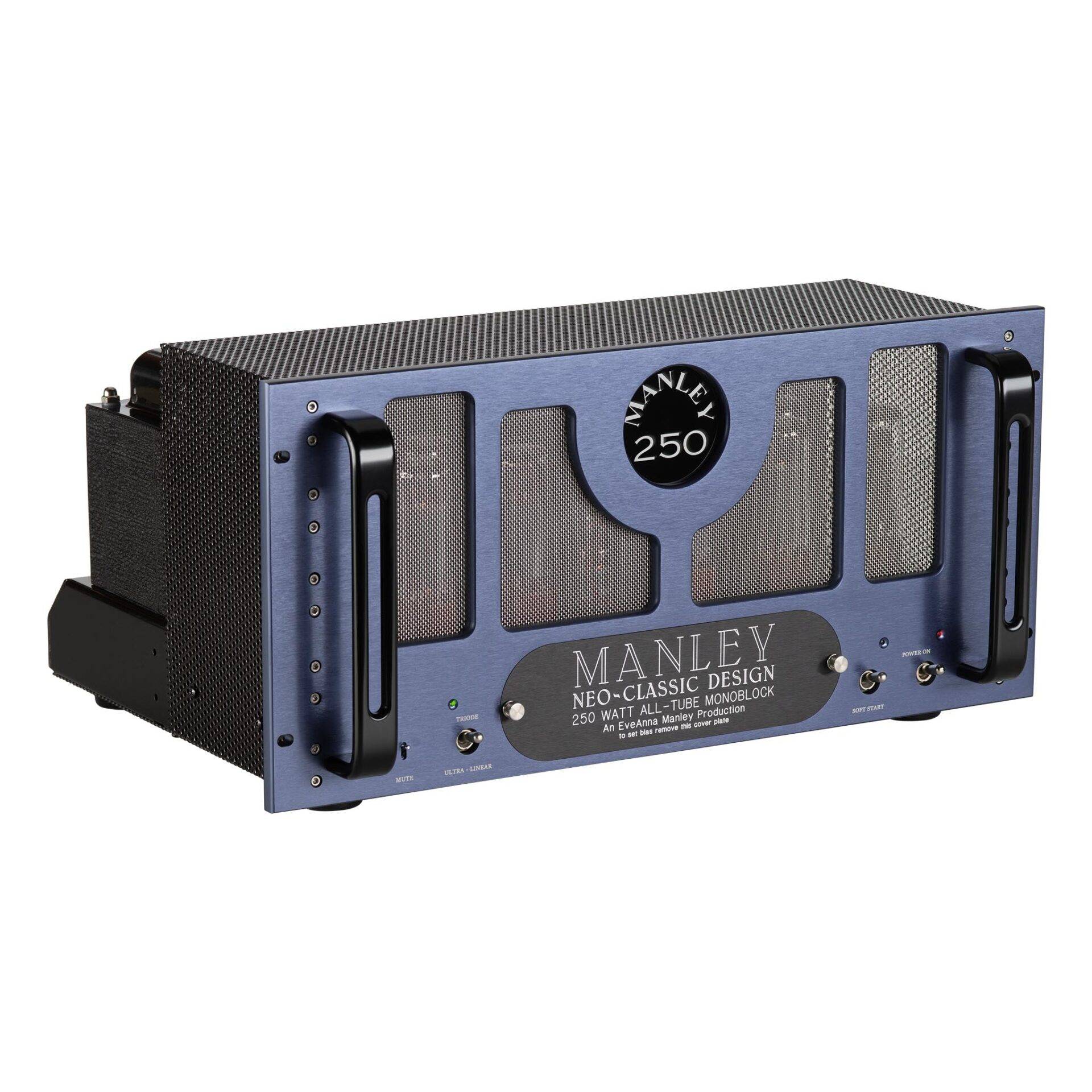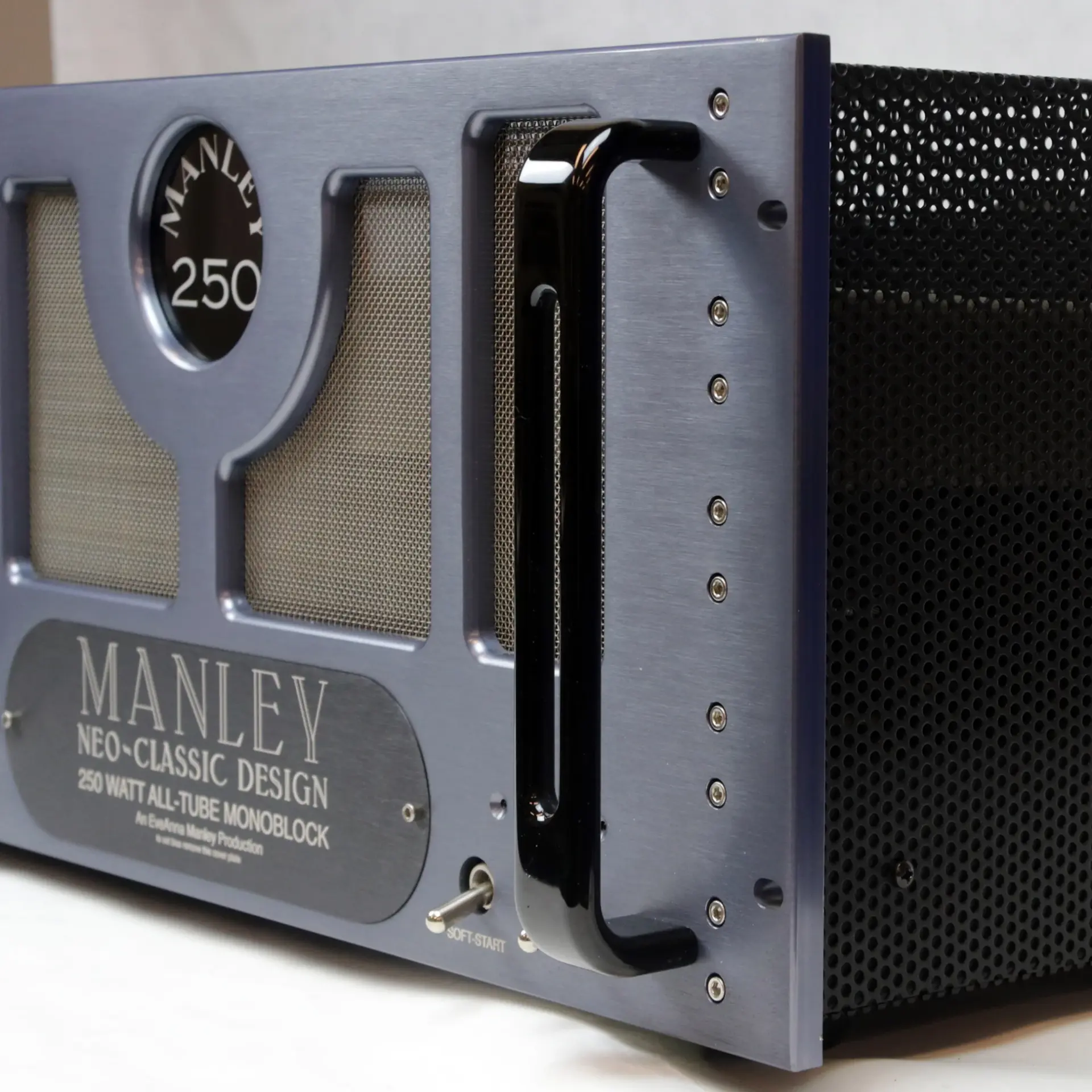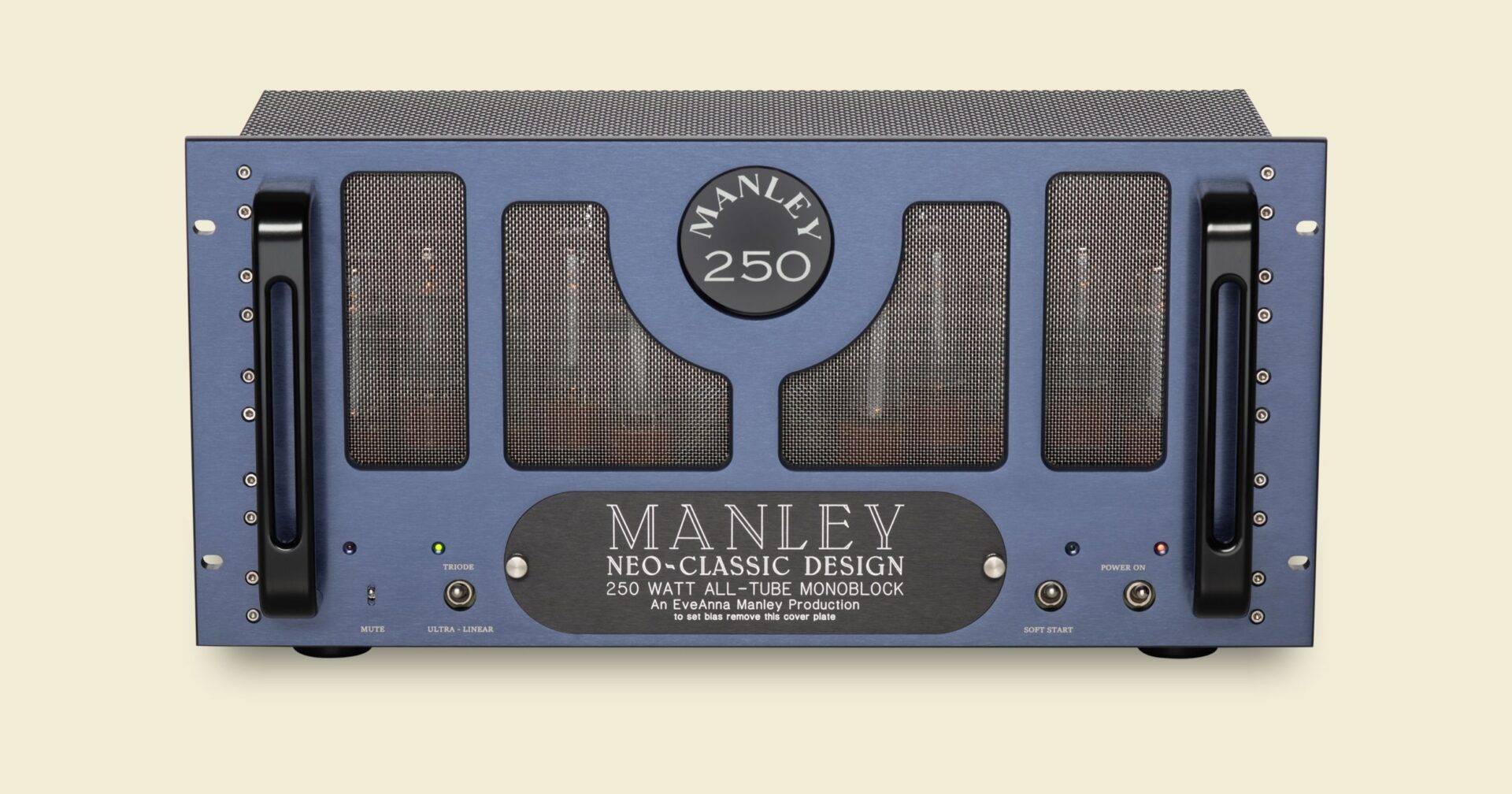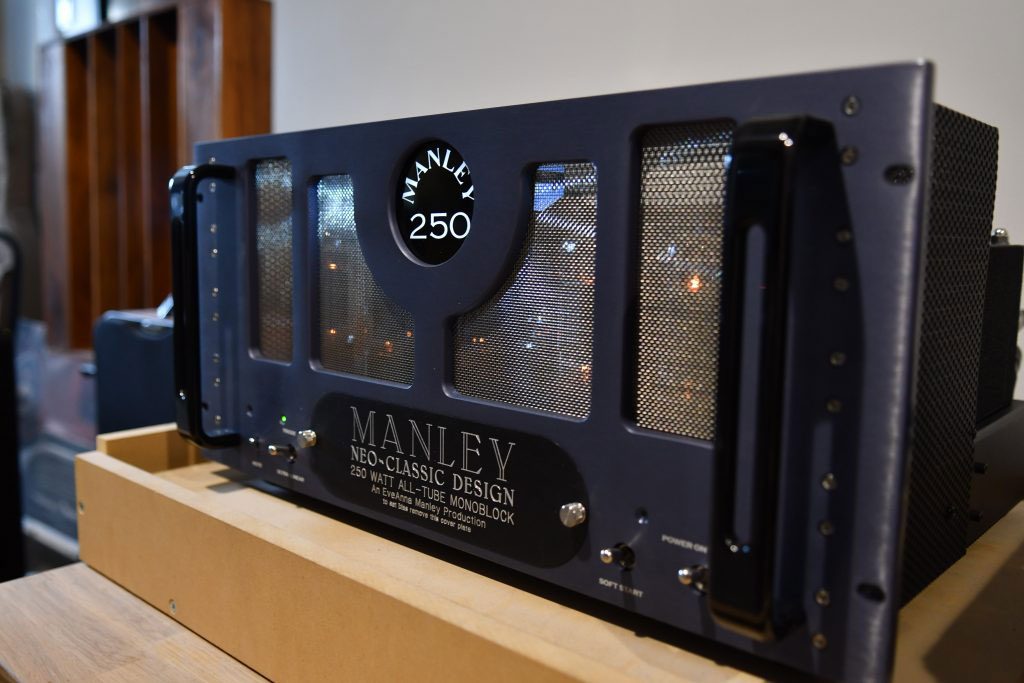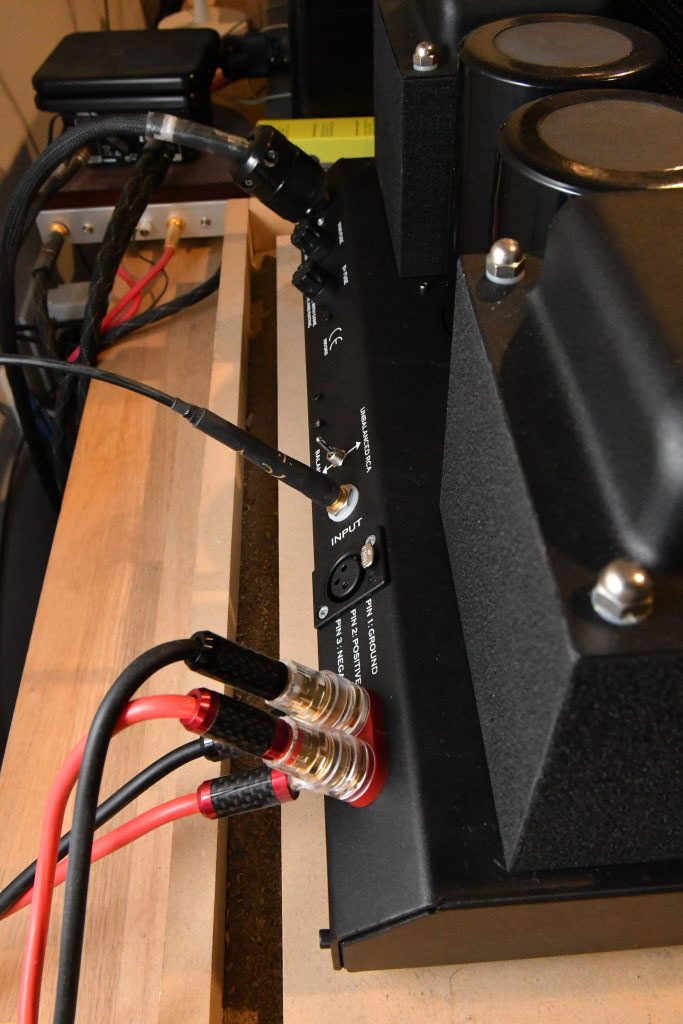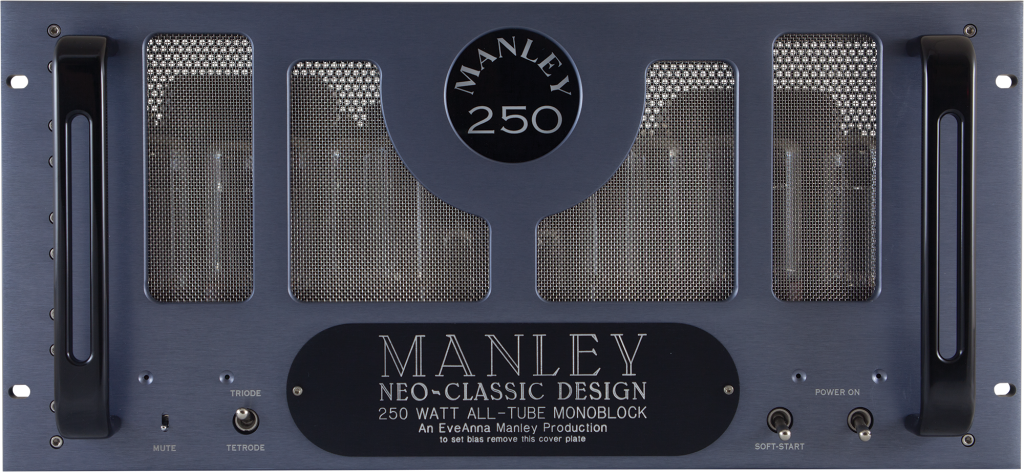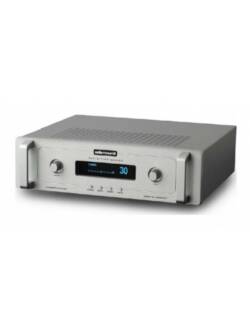Manley Neo-Classic 250 Monoblock Amplifiers (Set 1)
Original price was: R485,000.00.R145,000.00Current price is: R145,000.00.
SPECIFICATIONS
-
ALL-TUBE monoblock design: uses 10 x Tungsol EL34B output tubes
-
Driver Stage: High current double 12BH7EH (x2)
-
Input Tube: 12AT7
-
BALANCED & UNBALANCED inputs: RCA and XLR jacks (switchable)
-
MANLEY IRON® Input Transformer for the XLR: 2:1 ratio designed and wound at Manley Labs
-
MUTE switch: on front panel
-
TRIODE / Ultra-Linear output mode switching: on front panel
-
SOFT-START turn on mode: minimizes in-rush current by first powering up amplifier to half voltages
-
EVER-WARM mode: for standby keeps tubes warmed up at half voltages
-
MANLEY IRON® Output Transformer: designed and wound at Manley Labs
-
Front panel bias measurement and adjust: Concealed under the black oval insert
-
Output Tube Standing Current: 30mA
-
Set Bias for: 300mVDC measured across each bias tip jack to ground
-
Large filter / reservoir capacitors: 3800uF x 2
-
Angled rear of chassis: provides for easy connections
-
WBT binding posts: CE compliant for European models
-
Input Sensitivity RCA: Triode = 1.17 V; UL = 1.38 V for full power into 5 Ohms
-
Input Sensitivity XLR: Triode = 2.56 V; Tetrode = 3.05 V for full power into 5 Ohms
-
Input Sensitivity RCA Triode: 98.3 mV; UL = 86.6 mV for 1 Watt into 5 Ohms
-
Input Sensitivity XLR Triode: 227 mV; UL = 200 mV for 1 Watt into 5 Ohms
-
Gain RCA: Triode = 27.2 dB; UL = 28.3 dB
-
Gain XLR: Triode = 21.2 dB; UL = 22.3 dB
-
Input Impedance RCA: 130 kOhm @ 1KHz
-
Input Impedance XLR: 278 kOhm @ 1KHz; 20 kOhms @ 20KHz; 28 kOhm @ 20Hz
-
Actual Output Impedance Triode: 0.610 Ohm
-
Actual Output Impedance Tetrode: 0.698 Ohm
-
Optimum Speaker Load: 5 Ohms
-
Damping Factor Triode: 13.1
-
Damping Factor Tetrode: 11.5
-
S/N Ratio: 94 dB A-WGT at 1 Watt into 5 Ohms
-
Dynamic Range: 114 dB A-WGT
-
Noise Floor: -84 dB or 50 µV A-WGT 1 Watt into 5 Ohms w/Shorted Input
-
Frequency response -1 dB: Triode = 10 Hz – 30 kHz
-
Full Power frequency response -1 dB: Triode = 10 Hz – 33 kHz; UL = 10 Hz – 20 kHz to reach 1.5% THD into 5 Ohms
-
Distortion: Triode = 0.052%; UL = 0.37% BW 10 Hz – 500 kHz at 1 Watt into 5 Ohms
-
Full Power Triode: 140 W @ 1.5% THD into 5 Ohms
-
Full Power UL: 250 W @ 1.5% THD into 5 Ohms
-
Power Consumption: 40 Watts in “EVER-WARM” mode
-
Power Consumption Idle: 335 Watts
-
Maximum Power Consumption: 710 Watts at full power
-
Operating Mains Voltage: Factory set for 100V, 120V or 220-240VAC operation for original destination country’s mains voltage.
-
Operating Mains Voltage: changeable with power transformer replacement and fuse value change.
-
Mains Voltage Frequency: 50 Hz or 60 Hz
-
Mains Fuse 100-120VAC operation: MDA 10 Amp SLO-BLO Ceramic Time-Delay fuse
-
Mains Fuse 220-240VAC operation: MDA 8 Amp SLO-BLO Ceramic Time-Delay fuse
-
B+ Fuse: MDA 1 1/2A SLO-BLO Ceramic Time-Delay fuse
-
Badge Illumination: Units produced before 4/2003 use 8V, 0.3A “Fuse-Lamp” 1/4″ X 1 1/4″
– Serial numbers after N250188 use LED illumination which probably won’t burn out -
Power Cord: Detachable IEC standard. Appropriate power cord supplied for destination country
-
Unit Dimensions: W=19″ x D=13″ x H=9″ each
-
Unit Weight: 69 lbs. each
-
Shipping Box Dimensions: 22” x 19” x 18”
-
Shipping Weight: 79 lbs. each
Description
Manley Laboratories 250 Neo-Classic monoblock power amplifier
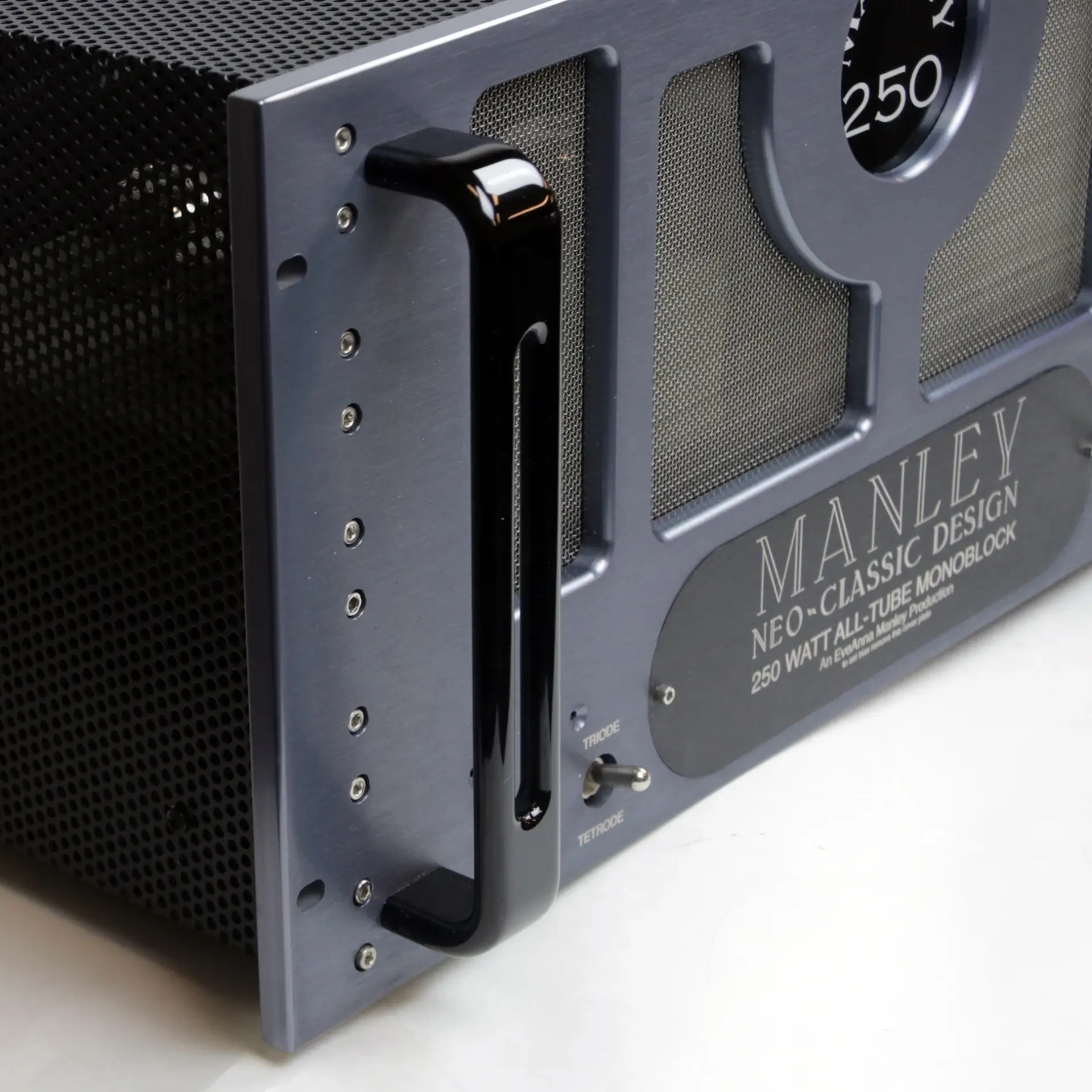
Manley also knows sound, and spends much of her professional life catering to an even pickier crowd than us hi-fi hounds: Manley Labs is a major presence in the pro audio and recording markets. The Manley Labs VoxBox microphone preamp and vocal processor, Slam limiter and mike preamp, and Massive Passive stereo EQ are but a few of the highly regarded Manley professional products found in top studios around the world. Not surprisingly, tubes are a central part of each of them.
While Manley Labs could happily perk along solely as a premier pro-audio company, EveAnna Manley wants equally great sound at home, and since she’s the boss, there is also a complete line of Manley Labs audio gear. From the highly practical Shrimp preamp and Stingray integrated all the way up to the mighty Steelhead phono stage and the 250 Neo-Classic, there’s a Manley component for almost every system and budget. And every one is tubed.
Nuts and Bolts, Tubes and Transformers
The 250 Neo-Classic is a stem-to-stern update and revision of the Reference 250 amplifier, reviewed in Stereophile in May 1996 (Vol.19 No.5). Its circuitry is as straightforward and rugged as a V-twin motorcycle engine, devoid of anything extraneous: the input stage is a paralleled dual-triode 12AT7WA from EI in Yugoslavia. The 12AT7WA is coupled to the driver/phase-splitter stage by a polypropylene rolled film-and-foil capacitor. There, two dual-triode 6414s (or 12BH7As, if available) are set up in a long-tailed splitter configuration—but the 250 parallels the tube stages, which, according to Manley, “yields more gain by doubling the transconductance of the tube, [resulting] in higher headroom with lower noise.”
The signal’s positive and negative phases then head for the output stage, where 10 Sovtek EL34G/Electro-Harmonix EL34EH tubes provide the electromotive force (footnote 1). The output tubes are biased to 27mA at idle, and bias adjustments for each tube are accessed behind the amp’s nameplate, which has a diagram and adjustment instructions etched on its back side. Global negative feedback is limited to a modest 12dB.
While Manley will happily talk about the circuitry of the 250, she uncharacteristically clams up when it comes to the specially designed output transformer. Unlike most amp builders, Manley Labs manufactures all of its transformers in-house, at its Manley Magnetics division. The 250’s output transformer embodies, on a much larger scale, advances in transformer design made while developing the Stingray integrated amp. Manley asserts that it is this transformer that is largely responsible for the amp’s sound, and is the primary contributor to the 250’s bass performance.
A particularly cool feature of the Neo-Classic is its ability to operate in both triode and tetrode modes. In tetrode mode, the 250 delivers 250W into a 5 ohm load and, with the flick of a front-panel switch, 100W of triode power are available (footnote 2). In tetrode mode, the screen grids of the output tubes are attached to the center tap of the output transformer’s primary windings. Switching to triode mode hooks up the screen grids to the anodes, electrically rendering the EL34 a three-element tube.
The power supply is proportionately beefy, uses high-speed solid-state rectifiers, and provides 320 joules of power storage for the amp’s B+ voltage rail. The 250’s thirst for electricity mandates a two-stage soft startup: the mains switch puts the amp into Standby/Ever Warm. At this point, the primaries see only half of the full-power-on voltages; throwing the Operate switch brings the amp up to its full operating voltages. Flick off the Input Mute switch and you’re ready to go. The handily slanted back panel provides a stout set of WBT speaker posts, access to fuses, and a switch to select between the single-ended and transformer-coupled balanced inputs.
System Specifics
I listened to the Manley 250 Neo-Classics on and off for several months to acclimate myself to their character within the context of my system, then settled down to the serious business of review listening. The 250s sat atop shot-loaded Grand Prix Audio Monaco amplifier stands and were hooked up with Wireworld Gold Eclipse 3+ interconnects and biwire speaker cables. For triode-mode listening I also used my efficient, sweet-tempered Silverline Sonatas as an alternate reference to my usual Apogee Duetta Signatures. As the 250s particularly liked the CPCC Top Gun and Wireworld Silver Electra 3+ power cords, I used them for all evaluative listening.
Like most tube amplifiers, the Neo-Classics didn’t need a lengthy break-in period—a couple of weekends’ listening and they’d settled down nicely. If there were any significant sonic changes after that point, they were too subtle for me to notice. I make a point of firing up tube amps at least an hour before doing any serious listening, the better to let everything thermally stabilize, and apart from one check of the output tubes’ bias (footnote 3), that was all the attention the Manleys required. There was nothing intimidating about living with the 250s; if you can read the manual and use a screwdriver and a multi-meter, you’re all set.
Tetrodes, Torque, and Traction
I began with the Manleys in tetrode mode. Unsurprisingly, they made a strong initial impression of relaxed but enormous strength. These amps took hold of a signal and controlled it effortlessly. My Apogee Duettas are quite power-hungry, but the 250s never seemed to be doing anything but loafing along, even at very high volumes. Take “Fracture,” from King Crimson’s Starless and Bible Black (LP, Editions EG EGKC7). Here, Crimson explores the gamut of dynamics, from quiet bits of skeletal solo guitar and electric violin to the terrifying roar of the tune’s recapitulation. When the band slams in out of nowhere at apocalyptic volume for the last statement of the theme, a listener should be startled. I’ve heard this piece hundreds of times, but the Manley-Apogee combination made me almost jump through the ceiling. To do this requires immense reserves of power, and that the Neo-Classics had. Oh brother, did they ever.
Power and control are fine, but even more important are fidelity to timbre and to the sound of the original recording acoustic. The 250 was slightly laid-back in its overall presentation. While revealing, it didn’t throw the sonic failings of bad recordings directly into my face. The amp passed flawed recordings with a kind of good-natured resignation, as if to say it would appreciate something that could let it show off to the fullest.
The 250’s bass immediately grabbed my attention. Manley’s claims for the their output transformers were backed by the amp’s performance. Just what proprietary magic is wrapped up in those transformers EveAnna Manley isn’t telling, but the bass performance of the Neo-Classic was right at the state of the art for tube amplifiers, and mightily impressive for any amp (footnote 4). Kruder and Dorfmeister’s “Jazz Master,” from The K&D Sessions (CD, G-Stone K-7073CD), and “The Robots,” from Kraftwerk’s The Mix (CD, Elektra 60869-2), have monstrous deep bass; the 250s shook the walls of my listening room with ease.
The 250 wasn’t just about bass power; it could boogie, too. The Manley hit me with its rhythm stick in a big way on Talking Heads’ Remain in Light (LP, Sire SRK 6095), throwing down the bass-heavy funk of “The Great Curve” and “Crosseyed and Painless.” The machine-gun exchanges between Victor Wooten’s bass and Future Man’s electronic “drumitar” on Béla Fleck and the Flecktones’ Live Art (CD, Warner Bros. 46247-2) never smeared or congealed, remaining calmly separated in space so I could groove on the amazing musicianship of both players.
The 250’s performance with acoustic bass instruments was, if anything, even more impressive. The amp dug into upright bass, providing a tremendous sense of grip and control while letting the resonance of the instrument’s big body bloom naturally into the room. The growling basses on “Journey to the Line,” from The Thin Red Line soundtrack (CD, RCA 63382-2), had the necessary sense of oppressive weight and deep mournfulness the music demands.
A sexy, smoochy, harmonically rich midrange is to be expected from a great tube amp, and it was assuredly on display with the Neo-Classic. Carly Simon’s “Last Night (When We Were Young),” from Film Noir (CD, Arista 18984-2), was so seductive and enticing through the Manleys that it would have taken a first-class heel to complain about anything. All I wanted to do was pour the lovely lady a drink and listen to her sing to me, oblivious to the rest of the world.
The 250s were just as fine with orchestral material. When I played excerpts from Aida and Samson et Dalila (LP, Ballet from the Opera, RCA Victor/Classic LSC-2400), the Manleys presented a big, open, well-defined acoustic, and clearly defined the various sections of the orchestra. The sounds of Zino Francescatti’s solo violin and the orchestra’s massed strings in Beethoven’s Violin Concerto (LP, Columbia Masterworks MS 6263) were marvelous, and the 250 did a particularly fine job of handling the tonal subtleties of the woodwind parts. And all that power on tap allowed the concerto’s noble themes to be stated with majestic weight and dynamics.
I occasionally found myself wishing for just a bit more spritziness in the top treble, but the 250’s smooth, balanced upper octaves were so perfectly in tune with the rest of the amp’s burnished but detailed sound that it would probably have been a bit distracting and out of character. Could there have been just a bit more sheen on massed violins? Yes, but the overall presentation of orchestral material was so continuous and convincing that, the longer I listened, the more pointlessly nit-picky such criticism seemed. Concert-hall sound is detailed and lively, not hi-fi bright. So was the Manley.
The Neo-Classic’s transient response was as good as that of any transformer-coupled tube amplifier I’ve heard. The attacks of aggressively bowed violins and percussion instruments of all kinds were convincing and true in character. The leading edges of cymbal, triangle, and piano transients and the picked strings of acoustic guitars were well-defined, with just the right blend of immediacy and freedom from etch or exaggeration.
Soundstaging was another of the Neo-Classics’ strengths. The vast spaces created by Future Sound of London’s Brian Dougans and Garry Cobain on the stunning Papua New Guinea Translations (UK CD, Jumpin’ and Pumpin’ CD TOT52) were deep, rich, and densely filled with sonic exotica. FSoL creates an alternate sonic universe, and the Manleys threw me straight onto the holodeck. Papua New Guinea‘s highly complex mixes have layer upon layer arranged in multiplicities of interlocking patterns. The Neo-Classics managed to effortlessly sort it all out, and brought out the organic, holistic nature of this ultrahip, postmodern trip through the cosmic tropics (or is it the tropical cosmos?).
The 250s were flat-out great at giving me not only the sound but the feel of all the music I played through them. King Crimson’s The ConstruKction of Light (CD, Virgin 49261-2) is an assault—a jarringly industrial, dark, dense, and claustrophobic sonic world that is, if you can take it, compelling and exciting music. The Manleys made it as physically punishing as three rounds with Lennox Lewis, just as Crimson intended it to be, but never lost track of the musical content.
Nothing could be more different from ConstruKction than The Band’s eponymous second album (CD, Capitol 25389-2-8). The Band is steeped in the feel of the post-Civil War era—homespun, rural, and earthy—and the plaintive harmonies, resonant guitars, and gloriously woody thud of Levon Helm’s kick drum were simply sublime through the 250s. Through the 250s, Helm’s keening vocal on “The Night They Drove Old Dixie Down” took me to a time and place far from my listening room in suburban Minneapolis in a display of pure musical alchemy.
Triodes, Tasty and Touchable
The ability to switch between tetrode and triode modes makes the 250 an audio neurotic’s dream. While power output is reduced in triode mode, it has its own rewards. Not that 100Wpc of triode power is anything to sneeze at—that was enough to drive my Apogees without clipping on anything but the largest-scaled music. In triode mode, the Manleys handled the 93dB/W Silverline Sonatas as effortlessly as tetrode mode dealt with the Apogees. Which is to say that they could bounce the speakers around the room like racquetballs if I cared to listen at such crazy levels.
The 250’s character was not all that different in triode and tetrode modes, but some of the differences were worth exploring. Triode mode gave a wonderfully intimate sound, more rich and luscious than tetrode mode, but exacted a slight tradeoff, with slightly reduced back-of-the-stage resolution. With big orchestral music, tetrode gave a slightly clearer look to the farthest reaches of the stage with the Apogees and the Silverlines, but triode really shone with smaller ensembles.
Listening to Jesse Cook’s Free Fall (CD, Narada 49290-0-8), bass definition and extension remained topnotch, and while a wee bit of tetrode’s sense of space and air was sacrificed, there was no loss of focus to Cook’s lightning-fast guitar work. Even the rasgueado flamenco technique, in which the fingers are flicked downward in rapid succession over the strings, was snappily defined. Cook’s guitar was lively and present, imbued with a nicely resonant and woody quality. The Manley’s way with acoustic guitars was also to the fore on a superb LP by Anthony Phillips and Enrique Berro Garcia, Antiques (PVC 8968). In triode mode, the Manley showed that, far from being a mere muscle amp, it was capable of great delicacy and refinement.
Triode mode did not impair the amp’s dynamic wallop. Dannie Richmond’s drum solo on Charles Mingus’ “Boogie Stop Shuffle” (LP, Mingus Ah Um, Columbia/Classic CS 8171) burst into the room through the Apogees, and Chris Maitland’s forceful but subtle drumming on Porcupine Tree’s live Coma Divine (UK CD, Delerium DELEC CD 067) lost none of its expressiveness. Big brass choruses, like that on the Barbirolli-Hallé performance of Sibelius’ Finlandia (LP, EMI ASD 2272), were rich and round: trombones and horns had great body and weight. The music of Berlioz is about nothing if not orchestral sumptuousness, and the Manley-Silverline combination delivered in fine style. Hearing the Roman Carnival Overture (LP, EMI ASD 3080), I noted the capacious soundstage, the amps’ accuracy in rendering the wide variety of orchestral colors, and the way the tambourine and cymbals made themselves clearly heard above the ensemble.
The reflective melancholy of Mingus’ “Goodbye Pork Pie Hat” and the urban night song of the sax solo in “Open Letter to Duke” were simply beautiful things—music that penetrated to the core of meaning and feeling. The Manleys captured the highly personal expression and plain old soul that were the core of Mingus’ music in either mode, but triode added an extra frisson of emotional connection. With big rock and orchestral recordings, there was a bit more transient snap and immediacy in tetrode, but with jazz, folk, and small ensembles recorded in less imposing spaces, the triode glow was the way to go.
Like a big ol’ Harley-Davidson, only better…
The 250 Neo-Classic had that hard-to-define quality that is instantly apparent when heard: a fundamental fidelity to the music. Its character was a bit forgiving, particularly in triode mode, but it did justice to the timbral and spatial microdetails found on the best recordings. In tetrode mode, it should handily drive any speaker I’ve ever heard to Stupid-Approved loudness levels in anything short of an airplane hangar.
Like its ebullient author, the 250 Neo-Classic utterly lacked anything resembling pretentiousness. In a sense, the big Manley was anti-“hi-fi.” Its sonic personality was honest to the core and completely unfussy, treating music as a thing to be loved and cherished, not as a collection of sounds to be picked apart and analyzed to death.
The Manley Laboratories 250 Neo-Classic is the Harley-Davidson of amps: big, whompingly powerful, with cool retro style to burn, and a burly, broad-shouldered presence that inspires great confidence. And no Manley owner will ever need to worry about oil drips.
Take a pair of 250s out for a spin. You’ll definitely enjoy the ride.
![]()
Manley Neo-Classic 250 Monoblock Amplifiers
Power and Passion
Review By Rick Jensen

The Manley Neo-Classic 250 monoblock amplifier is a great amplifier, but more than that, it is a work of passion. That might or might not seem a compliment, depending on what one thinks of the design and manufacturing process. To say that passion is manifest in a product conjures images of the guy working in his garage, and of course, nothing could be further from the truth. Manley Labs is a well-established high-end hi-fi and pro audio manufacturer.
Still, something more comes through this product, and the something more is light years from the cool, scientific, killer competence communicated by the likes of Krell or Mark Levinson. Yes, maybe it is tempting to romanticize the 250 because (a) it’s a tube product, (b) it is retro looking, and (c) as we shall see, there is richness to the sound. However, the amp is at the same time an “industrial-quality” unit, built like a battleship, and anything but a likeness of the modest tube amps of yore (and the cute little passion-inspiring SET’s of today). The pair of Manleys takes up a good amount of space in the room, they are quite heavy (about 70 lbs. apiece), and the name “Manley” is pretty prominent on the fascia – not cute and very solid. But passion there is, both in the music that comes through the amps, and in the reactions they inspire in the listener.
Tube DNA
As has been well-documented elsewhere in reviews of Manley products, the company is led by EveAnna Manley, one of the most enjoyable and exuberant people in the business of audio. EveAnna apparently didn’t have any choice in the tube/solid state debate, being the daughter of the owner of Ampeg. Equally apparent is that it was preordained that she would go into pro audio, and Manley is one of the handful of high-end audio companies with a real presence in the pro market. (About 85% of Manley’s business in the pro segment, though the home segment is gaining, and while that is not always the guarantor of success in the high end, it does mean that the equipment has to work, day after day and night after night.)
For some more background on EveAnna and the company, go to her bio. I would recommend anyone who is interested to visit the Manley Labs web site and browse around – it is both enjoyable and informative, and it offers a bit of the flavor of the personality of the CEO.

The Neo-Classic 250’s arrived well packed and were a breeze to set up. The manual is informative and to the point. There is little to do — one has only to insert a few tubes and follow the turn-on procedure, which consists of two switches rather than one. An on/off switch does the obvious, and there is a switch for the “Ever-warm”, or standby, mode that allows the amplifiers to remain on most all the time. If one goes away to tour the vineyards of France, it is probably good to shut the amplifier off. Short of that, if you use it regularly, you can pretty much use the standby switch to keep the amp ready for use at all times. The power consumption in the “Ever-warm” mode is just 30 watts, so electricity usage and costs should not be a major problem.
As noted earlier, construction quality is very high, as one would expect with an amplifier in this price range. The WBT binding posts present no problems and make a great connection, the capacitors and transformers are humongous, and the tube sockets (one thing that always concerns me) are as tight and solid as I have seen. Connections to the rear are facilitated by an angled panel that is well marked for those whose eyes are not quite what they once were.
The Manley 250’s use EL-34 tubes sourced from Russia. Other tubes are possible, and Manley will give instructions as to how to re-bias. Two years ago the updated 250 design was revised in order to improve the sound. A major factor in the revision was the development of a new output transformer with an eye toward getting a firmer bottom end. Use of the new transformer drove other smaller changes. I should underline here that the guiding light at Manley in any design change is in the listening. Granted, everyone in the high end says that, and it is likely true in just about all cases. But in EveAnna Manley’s words, the technical changes that are made are measured against the highest standard: by “balancing measured response against what really makes your foot go tap tap tap, head go bob bob bob, and what makes those goosebumps appear and what makes you want to get emotionally involved”. That may be a highly technical explanation, but it hews close to the truth.
Listening Impressions
I started my listening in tetrode mode – mainly because I wanted to save triode for later. From the first moments, the 250’s essential character shone through, although there were to be some differences between triode and tetrode. On the Franck Sonata in A “Allegro” [Coup d’Archet 001], Johanna Martzy’s violin was sweet but well-defined through the mid and upper ranges; I noted the resiny quality of the bow with a fundamental sweetness that differed from my Music Reference RM-9II, as well as from the amplifiers I had had for review of late, such as the Blue Circle BC-8’s. Immediately suspicious that the sweetness was some tube trickery designed to ensnare me, I listened hard (with furrowed brow) for evidence of any lack of rigor or detail. No such luck – the piano accompaniment had authority and force, along with a convincing amount of weight, even in the quiet sections. Even more, it was evident from the groove noise of this superb recording that nothing much was being covered up.
A similar sweetness is the hallmark of Alison Krauss’ voice on New Favorite [Diverse/Rounder 001], one of the finest LP’s I have heard in years. On “Let Me Touch You For a While” and “The Lucky One”, her voice is nuanced and delicate, light and fast. Her use of very subtle changes in loudness to convey the message of the songs became very clear, as the 250’s made one aware of the tiniest changes in amplitude. At the same time, banjos were light, metallic and properly twangy – most definitely un-“tubey”. On “The Boy Who Couldn’t Hoe Corn”, Dan Tyminski’s tenor had a reedy thin character familiar to those who had the good fortune to see and hear the Foggy Bottom Boys in “O Brother, Where Art Thou?” Also worth noting was the rhythmic drive of Union Station that the 250’s let through – the band has razor-sharp timing and play at warp speed; again, the Manleys stayed out of the way and let the music shine.
Too intrigued by how all this might sound in triode, I shut the amplifier off and changed mode. And as good as tetrode was (I would have thought it close to perfect had I not made the change), I had little incentive to go back.
In triode mode, one could hear the chest and throat in Krauss’ voice as though she were in the room. Again, these are fairly quiet, sometimes even breathy, vocals. Similarly, the body of the guitar was present in every note; same as well for the banjos. I suspected that the bass guitar might have been a touch too heavy – a little extra in the mid-to-upper bass, but it was hard to tell. The overriding impression of the same music in triode mode was of beauty. There was a sort of glow on the guitars being strummed at once – I asked myself “is it right?” and “do I care?”
Switching to CD for a reality check on the triode siren – maybe too much beauty is a bad thing – I put on Mark Knopfler’s Sailing to Philadelphia (WB-CD 9 47763-2). From the get-go, you knew that the 250’s could rock. “What It Is” burst out at full speed, resonant and very dynamic. I noticed a complete lack of the usual chestiness in Knopfler’s voice – which is gravelly enough as it is – without any sacrifice of the earthy, rich foundation. Most important, the near-perfect pitch in Knopfler’s guitar punctuated the melody as I had never heard before. Even at low volume, the almost-tangible feel of each note from the guitar filled the room. Like a great dessert, you only needed a small amount to be filled with flavor.
On Sailing to Philadelphia, the 250’s in triode mode underscored the sweetness of James Taylor’s voice, which emerges in the second verse relaxed, gentle, and heavenly. The interplay of the two – one full of gravel, the other rail-thin but silky – was never more in evidence, and it’s what makes the title song so pretty.
One tends to focus on melody when listening to the 250’s. A great record from Terence Martin, a New York area folksinger, called Waterproof (available from Good Dog Records, P.O. Box 364, Montvale, NJ) is a melody-fest full of falsely naïve and wry, ironic lyrics. Martin has a voice a little like John Prine. It might also lend itself to the slight chesty emphasis that most hi-fi would add. Not here: on the title tune and on my favorite, “Cracks in the Sidewalk”, Martin’s voice is whispery, rough, and warm. Like no amps I have heard, the 250’s communicate the bittersweet, romantic-ironic complexity in his music. And it sounds just right, much the way that Martin sounds in person.
With the 250’s, I did what all reviewers and most ardent listeners do with new and exciting gear: I trotted out all the touchstones in my record and CD collection, whether great sounding or not, just to hear how they sounded. I was not disappointed at all. It would be superfluous, not to mention boring, to list disc after disc and how great they sounded, but it is worth citing a few that highlighted more of the strengths of the 250’s.
Coherency through the bass shone on “Rock You Gently” from Jennifer Warnes’ The Hunter (Private Music 01005-02089-2). This CD is a great test of deep bass, but the midbass is equally important and well represented. Here, instead of thin or antiseptic midbass, I noted a “bloom” on each note, an essential communication of tonality in the lower register that is too often missing. You do not notice that it is not there until you hear it done right, and then…. Though the bass overall is a bit artificial sounding (as is generally the case on CD’s for me), it is still tight and melodic at once and more satisfying than usual. Was there a light emphasis in the midbass? It may be that the richness of the Manley midbass made up for some essential dryness in the CD; however, it is not as though other recordings (notably LP’s) betrayed any extra fat in that region.
Somewhat more dramatically, the Bach “Passacaglia” from Fennell Favorites (Reference RR-43) demonstrated great fluidity in the quiet opening, where the oboes are delicate and full. Imaging in this live recording is natural, not laser-accurate, and the Manley amplifiers render the image with a feeling of depth and decent width. The hall perspective seemed a bit back relative to the norm. While I do not know the details of the recording – just where the mikes were placed – since the 250 amplifiers were not reserved in general, it seems to be a characteristic of the recording. The later cuts on the record, by the way, are properly dynamic and forceful, still with a mid-hall perspective, but seemingly dropping any barrier between the listener and the recording. On this record, I did sense a very small softening in the highs. Some of that may be attributable to the live recording and the concert-hall perspective, but even the brassier sections might have been reproduced with a laid-back softening.
Finally and briefly, I pulled out the MFSL Sinatra boxed set for some big band sound. On “Come Fly With Me” and others, the perspective and the sound were forward, albeit less so than with other amplifiers (except the Blue Circle BC-8’s, which also did a fine job here). My own RM-9II, the Linn Klimax, and the Mark Levinson 336 all gave a sharper, more etched rendering of the Sinatra. While it is difficult to say which is the most “correct” because the MFSL records are often bright, I have to say that the 250’s yielded by far the best music.
Conclusions
That’s what it comes back to, again – music. Amid all the subjective observations and objective measurements that one can muster, the ineffable, emotional feel of the music is what many of us are seeking. The Manley 250’s never miss giving the listener something of the music and everything that goes into making it. If there is no passion there (think of typical commercial pop, designed to appeal to a broad audience and sell zillions), well, that’s what you will hear – lots of nice notes with no substance. But if there is an emotional charge in the playing or the writing or better yet, both, the Manley 250’s reward you in spades. Whether it is the power and sadness in Martzy’s violin, or the exuberant rollicking of The Band on their second LP, or a quiet bittersweet country song, the 250’s take you there. They’re great in tetrode mode, but even better in triode. To be sure, I constantly asked myself if I was being hoodwinked, if that triode sorceress was casting the spell that has captured so many. I don’t think so, but once more, I don’t care. These are great amplifiers that make music in the home a joy.
| Tonality | 96 |
| Sub-bass (10 Hz – 60 Hz) | 94 |
| Mid-bass (80 Hz – 200 Hz) | 94 |
| Midrange (200 Hz – 3,000 Hz) | 96 |
| High-frequencies (3,000 Hz on up) | 92 |
| Attack | 92 |
| Decay | 94 |
| Inner Resolution | 92 |
| Soundscape width front | 90 |
| Soundscape width rear | 88 |
| Soundscape depth behind speakers | 90 |
| Soundscape extension into the room | 85 |
| Imaging | 90 |
| Fit and Finish | 96 |
| Self Noise | 95 |
| Value for the Money | 94 |
The Power of Tubes: Manley Neo-Classic 250W Monoblocks
For those who have been around audio for a while, Manley Labs has been an industry stalwart for a long time. Headed by EveAnna Manley they produce products for both the home and professional markets. I stumbled upon the company once again when I heard of a new headphone amplifier that they had recently developed (more on this in an upcoming review) and decided to revisit an old friend in the audio game. Searching on the current website led me to these monoblock amps that have been in the Manley Labs catalog for a number of years. I was curious to see what they would sound like, and a quick email to EveAnna was all that was needed to secure a review sample.
I wanted to give anyone not familiar with the brand an opportunity to get a little better introduction, so I sent EveAnna a few questions to highlight the brand and what has gone into these amps before the review process began. The history of the company and of EveAnna can be found HERE. I also asked her a few brief questions and below were her responses:
What was the design concept and what influenced the build?
The “Neo-Classic” moniker is dudes (sic) to delineate the earliest classic designs dating back to when David Manley was with the company, before 1996. This power amplifier has its roots planted firmly in those old days, and really represents a classic David Manley design that has survived fairly untouched to present day.
What updates have been done recently?
This design has remained quite stable over the years. Very minor changes to the power supply have been made over the years, but that’s really about it. Again, this design represents a throwback to the original big muscular vacuum tube amplifiers that David designed.
What are some of the highlights that you are proud about in its development?
From the onset there was something “right” about our most powerful amplifiers from the old days. Important, years ago, was to get the big power transformers quiet. I personally worked with a new vendor back in the 1990s to make this happen. And then in 1995 we started winding the output transformers in house. This enhancement of the factory capabilities allowed us to develop more advanced output transformer designs. And this is probably the most important element in the whole amplifier. All the sound is going through it, so we had better get it right! Beyond this, compared to any other high power tube amplifiers you can name, the Manley 250s represent an honestly priced American product. Big bang for the buck!
Unboxing
I received the monoblocks carefully packaged in custom foam, and double boxed to protect amplifiers from harm. They are definitely hefty, so careful attention was placed on not throwing out my back. The contents of the box revealed that not only do they provide a manual, but extra fuses (which look to be ceramic), power cords, a tool to set bias, and also a handy voltmeter. The little things provide a better consumer experience, and I appreciated that Manley provided all the necessary tools, and then some, to get a user started. The tube complement is already seated in the amps, and are ready to go. Removing the tube cages show that the rows of tubes are additionally protected by slabs of foam during transport. All of this is detailed in the manual, which has descriptions of what to do before turning them on. Being an owner of vintage VTL amps I smiled at the manual, as it had some tongue-in-check references and lighthearted dialogue that reminded me of my old VTL 140 manual.
Appearance
Once everything was unpacked and hooked up I had the ability to soak in the overall aesthetics of the amps. Manley has done a good job by providing an industrial retro look with a hint of modern touches. The front is dominated by a thick aluminum faceplate ready for rack mounting. It is precision milled, has a very attractive blued finish that is synonymous with the brand image, and has the prerequisite grab handles to lug the amps around when need be. The Manley name is proudly displayed in the front, with model and name. I love the fact that it proclaims the power output and that it is an all tube monoblock. The rear of the amp contains the all important transformers, which look dense, are heavy, and with a rap of the knuckles confirm that they are all business with no hint of echo or emptiness in the casing. The very back has the hookups with WBT binding posts, balanced and unbalanced inputs, and fuse holder. When the amp is powered up you are not only treated to the warm tube glow, but the front is adorned with “Manley 250,” which is backlit by a small led bulb. When listening in the dark the amp casts both the glow of the tubes and led logo, well played indeed. Overall the design is straightforward, utilitarian, and clean.
Operation
As the nameplate describes, this is an all tube amplifier. Using ten EL34B output tubes, two 12BH7EH for the driver stage, and a single 12AT7 for the input. The operation of this amp is very simple. Toggle switches operate all aspects except biasing, which is found behind the nameplate. For those that might be nervous about biasing an amp by themselves Manley has you covered with the informative manual, but also a short video that can be found on their website. The toggles have a great tactile feel, are responsible for turning the amp on and off, and determining whether or not you want to run it balanced or unbalanced. An additional feature allows for the amp to be in a low power, always on mode that Manley has named “ever-warm.” Power consumption is 30 watts when engaged and definitely helped when wanting to listen right away, as sonically the amps were more ready to sound their best, as well as saving tube life, because it negates the hard startup. The additional feature that Manley provides is that the amp is able to switch from full power tetrode 250-watts to lower power triode 100-watts.
Listening impressions
Starting the review process off I decided to go with my digital end. Listening to a little popular country with Thomas Rhett’s song “Die a Happy Man.” Right away I noted the melody to be well represented, and his voice clearly in the center to the mixed elements of the song. I find male country artists to have an honest quality to their voices that I appreciate. The amps portrayed the whole song very well, never seemed to lack on either end, and was a good start to the formal review process. One of the tracks that I like to test components overall reproducing quality is Daft Punk’s “The Son of Flynn” from the TRON: Legacy soundtrack. The electronic mix tests the rhythm, tempo and overall soundstage, and boy did these amps deliver. I find that sometimes high power does not necessarily equate to delicacy, especially with electronic music. These Manley amps presented the song coherently with correct pace, and with a wide soundstage where the music appeared in space appropriately.
I decided to slow it down and fired up Sean Rowe’s “To Leave Something Behind,” and was rewarded with great presence represented by great mids and high bass where his voice resides. The amps recreate a single voice, guitar, and limited accompaniment well. I was curious to see how well a female vocal track would fare, and threw on Kina Grannis’ cover of “Can’t Help Falling in Love” from the Crazy Rich Asians Soundtrack. The guitar in the beginning is faithfully rendered, and the transparency and resolution were evident. Her voice, tender and clear, came through, and she was able to make a classic song her own. These amps made you feel within the musical space, and I would say at times you are gifted with a front row seat in the nearfield listening position that I have my rig set up in. I immediately fired up “Cleopatra” (Acoustic Demo) from the Lumineers, and was transported to the sound space where the recording was made. I love it when a component brings you closer to how the artist created their music. These amps allow you to be a fly on the wall, where you hear details that were recorded, like it or not. With this notion, badly recorded music will literally be fingernails on the chalkboard, as these amps are a magnifying glass to your music collection and system.
In the end, how would I summarize these amps? They have great control, power, and coherence. They possess great extension in both high and low, and do it effortlessly. At no time did I feel they were straining. Reflecting on my time with these amps made me think of a great resto-modded automobile. For those who do not know what that is, a resto-mod usually consists of a classic car body with basically everything else redone to modern standards. These amps on the outside look like a classic amp, but beneath the surface they have been tweaked to modern standards without losing what made them originally special. If I had one criticism with these amps, it would be that although not clinical, they did not possess a classical tube amp bloom, or what some would say warmth. That type of musicality in an amp is subjective, and they did so many impressive things while I listened to them their strengths far outweighed a little warmth here and there when it came to reproducing human voices. What you get with the Manley Labs amps is classic workmanship, honest reproduction, and a hint of a vintage vibe that more people are coming to appreciate. It is not the newest product on the block, it is a tried and true application that prides itself on reliability, power, and control. These monoblocks are serious audio products that EveAnna and her team have made, but they also understand the joy of music and what these components can bring to the end user. Tubes rule! Give it a try. Take care!
